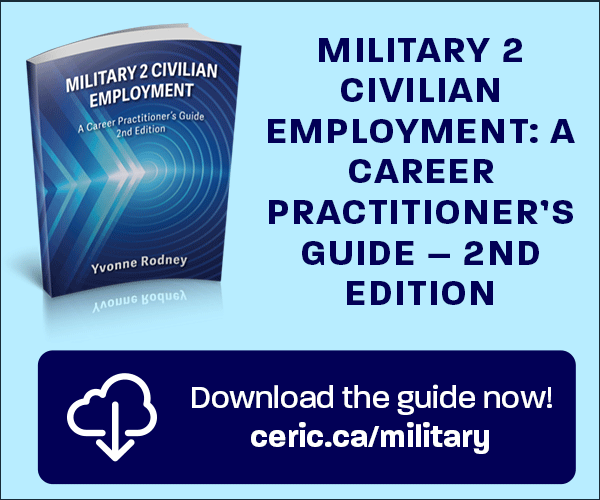Effect of Labour Market Information (LMI): Comparison Between Independent and Assisted Use of LMI
Abstract
According to a large meta-analysis (Brown and Ryan Krane, 2000), labour market information (LMI) is a critical ingredient in achieving career goals of individuals. This study aims to assess the effect of LMI use, with and without the help of a counsellor, taking into account the possible presence of differential effects according to client consultation needs (career choice or job search). Clients (n = 203) in job centres in New Brunswick and Saskatchewan were assigned randomly to two delivery modes: the independent self-help (use of LMI without help) or the assisted self-help (use of LMI with help of a counsellor). The results suggest that the LMI effect over time, although it is significant in both groups, is more important when participants are assisted by a counsellor. At the clinical level, this effect is moderate (Cohen, 1988). This result does not differ significantly according to the client consultation needs.
References
Amir, T., Gati, I. and Kleiman, T. (2008). “Understanding and Interpreting Career Decision-Making Difficulties”. Journal of Career Assessment, 16(3), pp. 281–309.
Amundson, N. E. (2000). Connecting Career Development and Public Policy with Counsellling Process Issues. Vancouver, BC: University of British Columbia.
Amundson, N., Harris-Bowlsbey, J. and Niles, S. (2009). Essential Elements of Career Counselling: Processes and Techniques (2nd ed.). New Jersey, NJ: Pearson (1st ed. 2005).
Baltz, C. (1995). “Le concept d'information: essai de definition”. Communication, 16(2), pp. 163–176.
Baudouin, R., Bezanson, M. L., Borgen, W., Goyer, L., Hiebert, B., Lalande, V., Magnusson, K. et al., (2007). “Demonstrating Value: A Draft Framework for Evaluating the Effectiveness of Career Development Interventions”. Canadian Journal of Counsellling, 41, pp. 146–157.Bernaud, J.-L. (2014). Méthodes de tests et questionnaires en psychologie. Paris: Dunod.
Bernaud, J.-L. Di Fabio, A. and Saint-Denis, C. (2010). “Effets subjectifs du conseil en orientation et satisfaction des usagers : une analyse des processus et des determinants”. Revue canadienne de counselling, 44(3), pp. 307–325.
Bougnoux, D. (1995). La communication contre l'information. Paris: Hachette.
Brown, S. and Ryan Krane, N. E. (2000). “Four (or Five) Sessions and a Cloud of Dust: Old Assumptions and New Observations about Career Counselling”. In Brown S. and Lent R.W. (dir.), Handbook of Counselling Psychology (3rd ed.), pp. 740–766. New York, NY: Wiley.
Cohen, J. (1988). Statistical Power Analysis for the Behavioral Sciences (2nd ed.). Hillsdale, NJ: Lawrence Erlbaum Associates, Inc. (1st ed. 1969).
Creswell, J.W. (2014). Research Design: Qualitative, Quantitative and Mixed Methods Approaches (4th ed.). Thousand Oaks, CA: Sage.
Drennan, J. and Hyde, A. (2008). “Controlling Response Shift Bias: The Use of the Retrospective Pre-test Design in the Evaluation of a Master's Programme”. Assessment and Evaluation in Higher Education, 33(6), pp. 699–709.
Field, A. (2009). Discovering Statistics Using SPSS (3rd ed.). London: Sage Publications Ltd. (1st ed. 2000).
Foskett, J. and Hemsley-Brown, J. V. (1999). “Invisibility, Perceptions and Image: Mapping the Career Choice Landscape”. Research in Post-Compulsory Education, 4, pp. 233–248.
Gati, I. and Levin, N. (2015). “Making Better Career Decisions”. In P. J. Hartung, M. L. Savickas and W. B. Walsh (dir.), Handbook of Career Intervention, pp. 193–207. Washington, WA: American Psychological Association.
Gati, I. and Tal, S. (2008). “Decision-Making Models and Career Guidance”. In J. Athanasou and R. Van Esbroeck (dir.), International Handbook of Career Guidance, pp. 157–185. Berlin, Germany: Springer.
Gottfredson, L. S. (1996). “Gottfredson’s Theory of Circumscription and Compromise”. In D. Brown, L. Brooks and coll. (dir.), Career Choice and Development(3rd ed.), pp. 179–232. San Francisco: Jossey-Bass.
Gysbers, N. C., Heppner, M. J. and Johnston, J.A. (2014). Career Counselling: Holism, Diversity, and Strengths (4th ed.). Alexandria, VA: American Counselling Association (1st ed. 1998).
Heppner, P., Kivlighan, D. and Wampold, B. (2008). Research Design in Counselling (3rd ed.). Belmont, CA: Thomson Higher Education (1st ed. 1999).
Hiebert, B. (2012). Assessing the impact of labour market information : Final report on results of phase two (field tests). Ottawa : Ressources humaines et développement des compétences Canada.
Kleiman, T. and Gati, I. (2004). “Challenges of Internet-Based Assessment: Measuring Career Decision-Making Difficulties”. Measurement and Evaluation in Counselling and Development, 37, pp. 41–55.
Krieshok, T. S., Black, M .D. and McKay, R. A. (2009). “Career Decision Making: The Limits of Rationality and the Abundance of Non-Conscious Processes”. Journal of Vocational Behavior, 75, pp. 275–290.
Labour Market Information Advisory Panel (2009). Working Together to Build a Better Labour Market Information System for Canada, Final Report. Minister of Human Resources and Skills Development Canada and Minister for Post-Secondary Education, Training and Labour of New Brunswick.
Masdonati, J., Perdrix, S., Massoudi, K. and Rossier, J. (2014). “Working Alliance as a Moderator and a Mediator of Career Counselling Effectiveness”. Journal of Career Assessment, 22(1), pp. 3–17.
Multon, K. D., Wood, R., Heppner, M. J. and Gysbers, N. C. (2007). “A Cluster-Analytic Investigation of Subtypes of Adult Career Counselling Clients: Toward a Taxonomy of Career Problems”. Journal of Career Assessment, 15(1), pp. 66–86.
Organisation de coopération et de développement économiques. (2013). Les grandes mutations qui transforment l’éducation 2013. Downloadable document available at < http://www.keepeek.com/Digital-Asset-Management/oecd/education/les-grandes-mutations-qui-transforment-l-education-2013_trends_edu-2013-fr#page1>. Viewed on October 7, 2013.
Patton, W. and McCrindle, A. (2001). “Senior Students' Views on Career Information”. Australian Journal of Career Development, 10(1), pp. 32–36.
Pratt, C.C., McGuigan, W.M. and Katzev, A.R. (2000). “Measuring Program Outcomes: Using Retrospective Pretest Methodology”. American Journal of Evaluation, 21(3), pp. 341–349.
Rochlen, A. B., Milburn, L. and Hill, C. E. (2004). “Examining the Process and Outcome of Career Counselling for Different Types of Career Counselling Clients”. Journal of Career Development, 30(4), pp. 263–275.
Rockwell, S.K. and Kohn, H. (1989). “Post-then-Pre Evaluation”. Journal of Extension, 27(2), pp. 19–21.
Sampson, J. P., Reardon, R. C., Peterson, G. W. and Lenz, J. G. (2004). Career Counselling and Services: A Cognitive Information Processing Approach. Pacific Grove, CA: Brooks/Cole.
Sampson, J. P., Lenz, J. G., Peterson, G. W. and Reardon, Effect of Labour Market Information (LMI)52R. C. (1999). “A Cognitive Information Processing Approach to Employment Problem Solving and Decision Making”. The Career Development Quarterly, 48(1), pp. 3–18.
Savard, R., Gingras, M. and Turcotte. M. (2002). “Delivery of Career Development Information in the Context of Information Computer Technology”. International Journal for Educational and Vocational Guidance, 2, pp. 173–191.
Savard, R., Michaud, G., Bilodeau, C. and Arsenau, S. (2007). “L’effet de l’information sur le marché du travail dans le processus décisionnel relatif au choix de carrière”. Canadian Journal of Counsellling/Revue canadienne de counselling, 41(3), pp. 158–172.
Savard, R. et Paquette, S. (2012). Mesure de l’effet de l’information sur le marché du travail : rapport final de la phase II, résultats de l’analyse des questionnaires. Ottawa : Ressources humaines et développement des compétences Canada.
Savickas, M. L. (1999). “Career Development and Public Policy: The Role of Values, Theory and Research”. In B. Hiebert & L. Bezanson (Eds.), Making Waves: Career Development and Public Policy: International Symposium 1999, Papers, Proceedings and Strategies(pp. 52–68). Ottawa, ON: Canadian Career Development Foundation.
Sharpe, A. (2009). Pratiques exemplaires en ce qui a trait à l’information sur le marché du travail: Recommandations pour le système d’IMT du Canada. CENV 2009-5 research report.
Tabachbick, B. G. and Fidell, L. S. (2001). Using Multivariate Statistics (4th ed). Needham Heights, MA: Allyn and Bacon.
Thuy, P. E., Hansen, E. and Price, D. (2001). The Public Employment Service in a Changing Labour Market. Geneva: IOL.
Whiston, S. C., Sexton, T. L.and Lasoff, D. L. (1998). “Career-Intervention Outcome: A Replication and Extension of Oliver and Spokane (1988)”. Journal of Counselling Psychology, 45(2), pp

Downloads
Published
How to Cite
Issue
Section
License

This work is licensed under a Creative Commons Attribution-NonCommercial-NoDerivatives 4.0 International License.
















